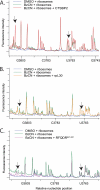Selenocysteine insertion sequence (SECIS)-binding protein 2 alters conformational dynamics of residues involved in tRNA accommodation in 80 S ribosomes
- PMID: 22308032
- PMCID: PMC3323001
- DOI: 10.1074/jbc.M111.320929
Selenocysteine insertion sequence (SECIS)-binding protein 2 alters conformational dynamics of residues involved in tRNA accommodation in 80 S ribosomes
Abstract
Sec-tRNA(Sec) is site-specifically delivered at defined UGA codons in selenoprotein mRNAs. This recoding event is specified by the selenocysteine insertion sequence (SECIS) element and requires the selenocysteine (Sec)-specific elongation factor, eEFSec, and the SECIS binding protein, SBP2. Sec-tRNA(Sec) is delivered to the ribosome by eEFSec-GTP, but this ternary complex is not sufficient for Sec incorporation, indicating that its access to the ribosomal A-site is regulated. SBP2 stably associates with ribosomes, and mutagenic analysis indicates that this interaction is essential for Sec incorporation. However, the ribosomal function of SBP2 has not been elucidated. To shed light on the functional relevance of the SBP2-ribosome interaction, we screened the functional centers of the 28 S rRNA in translationally competent 80 S ribosomes using selective 2'-hydroxyl acylation analyzed by primer extension (SHAPE). We demonstrate that SBP2 specifically alters the reactivity of specific residues in Helix 89 (H89) and expansion segment 31 (ES31). These results are indicative of a conformational change in response to SBP2 binding. Based on the known functions of H89 during translation, we propose that SBP2 allows Sec incorporation by either promoting Sec-tRNA(Sec) accommodation into the peptidyltransferase center and/or by stimulating the ribosome-dependent GTPase activity of eEFSec.
Figures







Similar articles
-
The selenocysteine-specific elongation factor contains a novel and multi-functional domain.J Biol Chem. 2012 Nov 9;287(46):38936-45. doi: 10.1074/jbc.M112.415463. Epub 2012 Sep 19. J Biol Chem. 2012. PMID: 22992746 Free PMC article.
-
Insight into mammalian selenocysteine insertion: domain structure and ribosome binding properties of Sec insertion sequence binding protein 2.Mol Cell Biol. 2001 Mar;21(5):1491-8. doi: 10.1128/MCB.21.5.1491-1498.2001. Mol Cell Biol. 2001. PMID: 11238886 Free PMC article.
-
The L7Ae RNA binding motif is a multifunctional domain required for the ribosome-dependent Sec incorporation activity of Sec insertion sequence binding protein 2.Mol Cell Biol. 2007 Sep;27(18):6350-60. doi: 10.1128/MCB.00632-07. Epub 2007 Jul 16. Mol Cell Biol. 2007. PMID: 17636016 Free PMC article.
-
Threading the needle: getting selenocysteine into proteins.Antioxid Redox Signal. 2010 Apr 1;12(7):881-92. doi: 10.1089/ars.2009.2878. Antioxid Redox Signal. 2010. PMID: 19747061 Free PMC article. Review.
-
On elongation factor eEFSec, its role and mechanism during selenium incorporation into nascent selenoproteins.Biochim Biophys Acta Gen Subj. 2018 Nov;1862(11):2463-2472. doi: 10.1016/j.bbagen.2018.03.018. Epub 2018 Mar 17. Biochim Biophys Acta Gen Subj. 2018. PMID: 29555379 Free PMC article. Review.
Cited by
-
Reconstitution of selenocysteine incorporation reveals intrinsic regulation by SECIS elements.J Mol Biol. 2013 Jul 24;425(14):2415-22. doi: 10.1016/j.jmb.2013.04.016. Epub 2013 Apr 23. J Mol Biol. 2013. PMID: 23624110 Free PMC article.
-
The selenocysteine-specific elongation factor contains a novel and multi-functional domain.J Biol Chem. 2012 Nov 9;287(46):38936-45. doi: 10.1074/jbc.M112.415463. Epub 2012 Sep 19. J Biol Chem. 2012. PMID: 22992746 Free PMC article.
-
Emergence and evolution.Top Curr Chem. 2014;344:43-87. doi: 10.1007/128_2013_423. Top Curr Chem. 2014. PMID: 23478877 Free PMC article. Review.
-
Chemical footprinting reveals conformational changes of 18S and 28S rRNAs at different steps of translation termination on the human ribosome.RNA. 2016 Feb;22(2):278-89. doi: 10.1261/rna.053801.115. Epub 2015 Dec 11. RNA. 2016. PMID: 26655225 Free PMC article.
-
Identification of nucleotides and amino acids that mediate the interaction between ribosomal protein L30 and the SECIS element.BMC Mol Biol. 2013 Jun 19;14:12. doi: 10.1186/1471-2199-14-12. BMC Mol Biol. 2013. PMID: 23777426 Free PMC article.
References
-
- Diamond A., Dudock B., Hatfield D. (1981) Structure and properties of a bovine liver UGA suppressor serine tRNA with a tryptophan anticodon. Cell 25, 497–506 - PubMed
-
- Jung J. E., Karoor V., Sandbaken M. G., Lee B. J., Ohama T., Gesteland R. F., Atkins J. F., Mullenbach G. T., Hill K. E., Wahba A. J. (1994) Utilization of selenocysteyl-tRNA[Ser]Sec and seryl-tRNA[Ser]Sec in protein synthesis. J. Biol. Chem. 269, 29739–29745 - PubMed
-
- Fahlman R. P., Dale T., Uhlenbeck O. C. (2004) Uniform binding of aminoacylated transfer RNAs to the ribosomal A and P sites. Mol. Cell 16, 799–805 - PubMed
Publication types
MeSH terms
Substances
Grants and funding
LinkOut - more resources
Full Text Sources
Molecular Biology Databases
Miscellaneous

